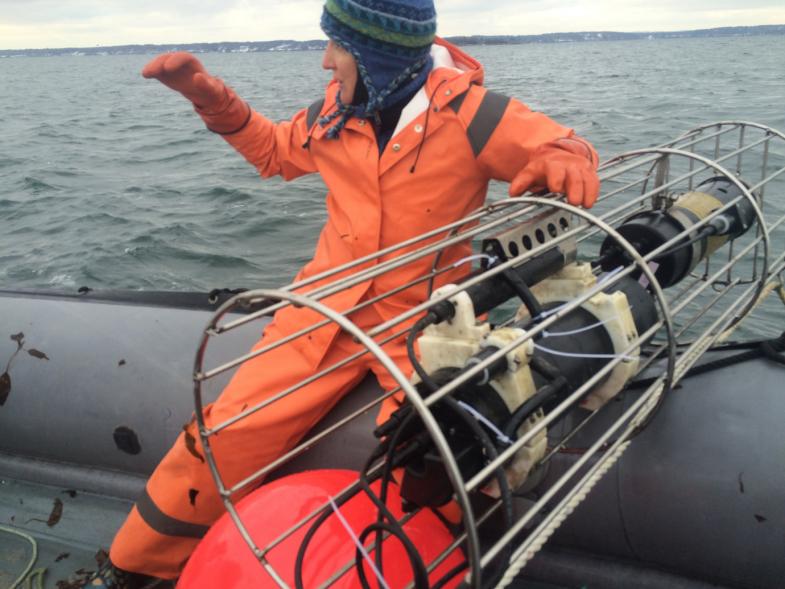
Susie Arnold explaining how instruments work at Paul Dobbins’ kelp farm off of Chebeague Island.
The Island Institute is partnering with Bigelow Laboratory for Ocean Sciences and Ocean Approved, the country’s first company to grow kelp for food, on an exciting new project with potentially big implications. As it grows, the kelp on Ocean Approved’s rafts in Casco Bay may capture enough CO2 to reduce the acidity of surrounding water and make shellfish grow better. The instruments measuring ocean chemistry were put in and outside of the farm a couple of weeks ago, and the first reading of CO2 levels is very promising.
Background: Ocean Acidification in Maine
Ocean acidification is a term used to describe the changing chemistry of the ocean due primarily to uptake of atmospheric carbon dioxide (CO2). This oceanic uptake of CO2 leads to decreases in pH and lower calcium carbonate levels, which can make it hard for lobsters, oysters, or mussels to develop properly. Maine is vulnerable from an environmental perspective, and also an economic one: Shell-forming organisms represent 85% of the value of Maine’s fisheries landings. 
To address this vulnerability, Maine was the first east coast state to convene a legislatively established task force to address acidification in its waters and its potential impacts on commercially important species. The Maine OA Commission Report recommendation 4.1 states: “Growing and harvesting macroalgae could play a considerable role in carbon sequestration. Determining the benefits of co-culturing macroalgae, such as kelp and shellfish, should be a research priority.”
While the negative impacts of ocean acidification on shell-builders like clams, oysters, scallops, and mussels have been relatively well documented, the potentially positive impacts of increased CO2 on seaweed have not been well studied. Initial research suggests that most species studied have increased productivity and growth. Even better, primary production of these seaweeds may be able to sequester enough CO2 to remediate local waters (called “phytoremediation”), suggesting that shellfish located in close proximity to seaweed aquaculture farms may benefit from improved growing conditions due to improved carbonate chemistry.
Pilot Project in Casco Bay
This pilot project tests if primary production from sugar kelp (Saccharina latissima) captures enough CO2 to remediate local waters. In early November, Paul Dobbins, president of Ocean Approved, seeded his kelp farm lines with kelp just barely visible to the naked eye. On January 8, instruments measuring CO2, pH, dissolved oxygen, salinity, temperature, and depth were deployed at the depth of the growing kelp (7 ft), inside and outside of his farm off of Chebeague Island.

Paul Dobbins prior to initial deployment of the instruments on January 8.
Approximately every two weeks, data is downloaded from the instruments, kelp biomass estimates are made, and discrete water samples, for total alkalinity and dissolved inorganic carbon, are taken at the surface, bottom (~10 m), and instrument depth (~2 m). Our first ten days of data indicate lower levels of carbon dioxide inside the kelp farm, which is very promising, since the kelp is only about 14 inches long. We will continue to collect data until after the kelp is harvested in late spring 2016, at which point it will be closer to 14 feet long! If significant phytoremediation potential is detected, we aim to investigate the feasibility of co-locating seaweeds and/or seagrasses with shellfish to improve the growing conditions for shellfish in the face of ocean acidification.

Susie Arnold, Nichole Price, and Brittney Honisch downloading instrument data on January 18.
In addition to the potential for seaweed farming to help remediate ocean acidification and provide a diversified income stream for lobster-dependent communities, there are compelling immediate environmental benefits that can accrue from shellfish and seaweed aquaculture. Both can improve local water quality. For example, oysters can filter up to 50 gallons of water each day and, in doing so, remove organic nitrogen and light-blocking microalgae, making the water clearer and improving growing conditions for seagrasses and seaweeds. Seaweeds in turn extract excess nutrients like nitrogen and phosphorus from the water column, as well as carbon, improving the growing environment for shellfish.

Contributed by